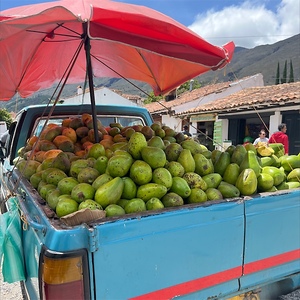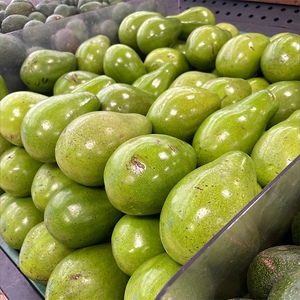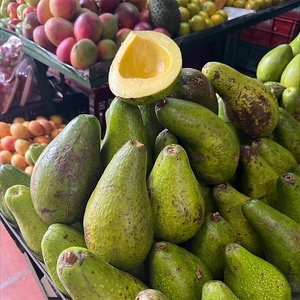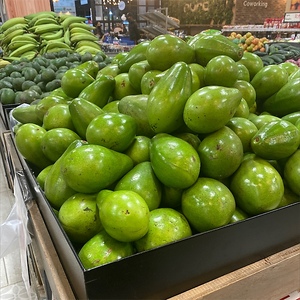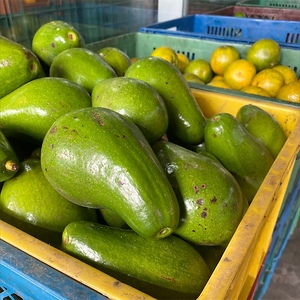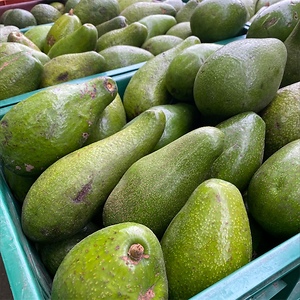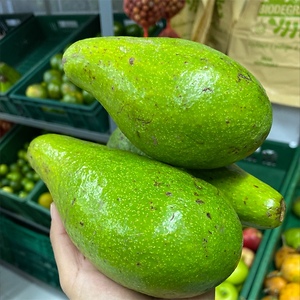


Colombian Avocados
Estimated Inventory, lb : 0
Description/Taste
Colombian avocados are medium to large fruits, averaging 4 to 12 centimeters in length, and have an elongated, oval to pyriform shape, sometimes bearing a distinctive long-neck and curved ends. The skin is very thin, flexible, smooth, and glossy, ranging in color from green to dark green-brown, containing some brown russet spots. Underneath the surface, the flesh is smooth, pale green-yellow, lightly fibrous, and creamy, encasing a large, central brown seed. Colombian avocados contain low oil, developing a denser consistency, and have a mild, aniseed flavor with subtle sweet and nutty notes.
Seasons/Availability
Colombian avocados are available in the late spring through summer and again in the fall through early winter.
Current Facts
Colombian avocados, botanically classified as Persea americana var. americana, is a general descriptor used to encompass many different native avocados growing in Colombia, belonging to the Lauraceae family. The creamy fruits are also known as Common, Creole, Native, or Criollo avocados, and depending on the growing region within Colombia, the fruits are also known under local names, including Leche, Cebo, Manteca, Santa Barbara, Chaparral, Alvarado, Sonson, and Uraba. Over half of the fruits sold in Colombian markets are Colombian avocados, but in recent years, Colombian avocados have steadily declined in production due to increased cultivation of hybrid varieties with improved growth characteristics. Colombian avocados are primarily sold for local consumption as the fruits widely vary in appearance, flavor, and texture depending on the growing season, region, and climate. Many native varieties are also grown in backyards and home gardens, contributing to the diversity among the fruits. Despite their decline, some growers in Colombia are taking an active stance to promote the native varieties and educate other farmers on the importance of diversity and preservation of unique cultivars.
Nutritional Value
Colombian avocados are a good source of fiber to stimulate the digestive tract, potassium to balance fluid levels, and vitamin C to boost the immune system and reduce inflammation. Avocados also provide magnesium to regulate blood pressure, vitamin A to maintain healthy organ functioning, and vitamin E to protect cells from external environmental aggressors.
Applications
Colombian avocados have creamy, dense flesh with a subtly sweet, aniseed flavor that is showcased when consumed fresh. The flesh can be peeled or scooped from the thin skin and sliced into salads, layered onto sandwiches, or cut and served as an edible garnish for dishes. Colombian avocados can also be mashed into guacamole, stirred into salsa, used as a topping for tacos, mixed into rice, blended into smoothies, or placed into soups. In addition to fresh uses, Colombian avocados are sometimes used to produce oils for cooking and are dried into powders for extended use, supplements, and beverages. In Colombia, avocados are often served with arepas, which are cooked cornmeal cakes either served as a side dish or snack. The buttery fruits are also sliced as a topping over the traditional dish, ajiaco soup, and are sprinkled with salt and served as a lunchtime snack. Colombian avocados pair well with meats such as poultry, beef, pork, and fish, eggs, potatoes, corn, tomatoes, leafy greens, radishes, aromatics, including garlic, onion, and green onions, and herbs such as cilantro, parsley, and basil. Whole, unsliced avocados will ripen at room temperature and should be consumed within 1 to 2 days once mature for the best quality and flavor. The fruits can also be stored in the refrigerator when ripe for an additional couple of days.
Ethnic/Cultural Info
Colombian avocados are celebrated at the Festival del Aguacate, also known as the Avocado Festival, in the city of El Carmen, located within the department of Santander, Colombia. The festival has been held annually in March for over 10 years and is sponsored by the government to encourage the continued cultivation of Colombian avocados. Many of the native varieties of Colombian avocados are being lost to disease and are being replaced with commercial hybrid varieties, but there has been a movement among non-profits and the government to educate growers on the importance of preserving the native fruits. The Festival del Aguacate features live musical performances, avocado-centric competitions, athletic events, and food vendors showcasing the native fruits in various culinary applications. The festival also connects local growers with other community members to expand and learn about avocado cultivation options.
Geography/History
Colombian avocados are descendants of avocados native to South-Central Mexico that have been cultivated since ancient times. The fruits were carried from Mexico to Central and South America through trade and migrating peoples in the early ages and were planted throughout subtropical and tropical areas of Colombia. Once the trees were established in Colombia, many new varieties were bred over time for improved characteristics, and the new regional cultivars were generally labeled under Colombian avocado for sale in local markets. Colombian avocados are the main avocados found in Colombia's neighborhood markets and are believed to be a type of West Indian avocado, a variety well-suited to humid, tropical regions. Today Colombian avocados are grown throughout the country in the departments of Curumani, Sucre, Bolívar, Atlántico, Magdalena, Tolima, Santander, and Antioquia and are sold through local grocers and fresh markets.
Recipe Ideas
Recipes that include Colombian Avocados. One



